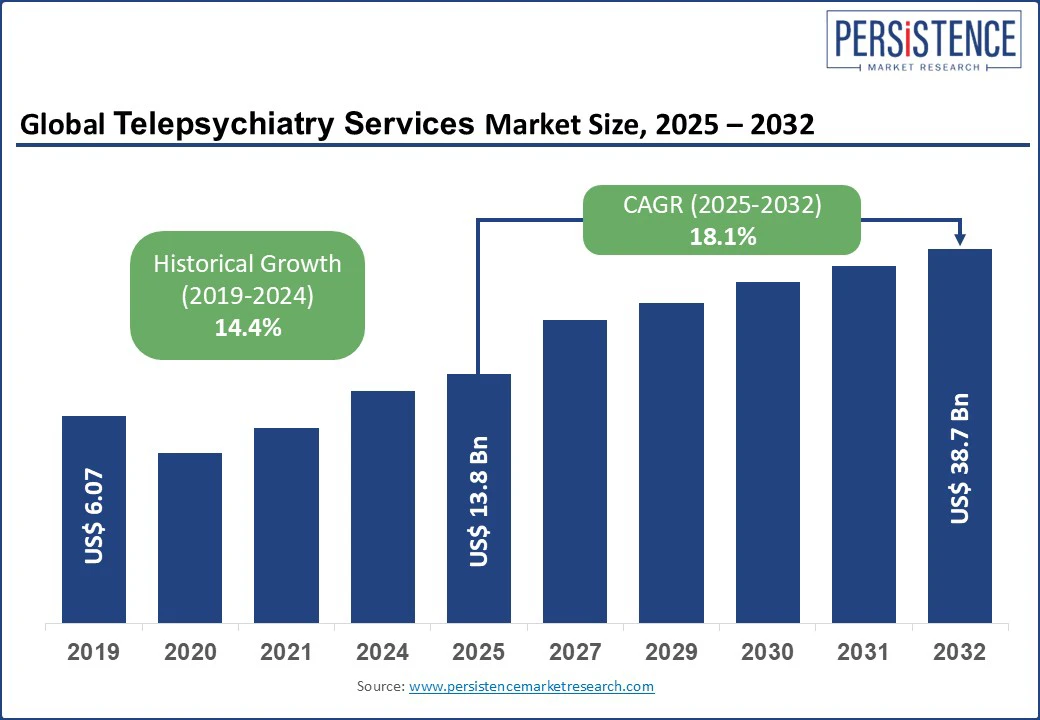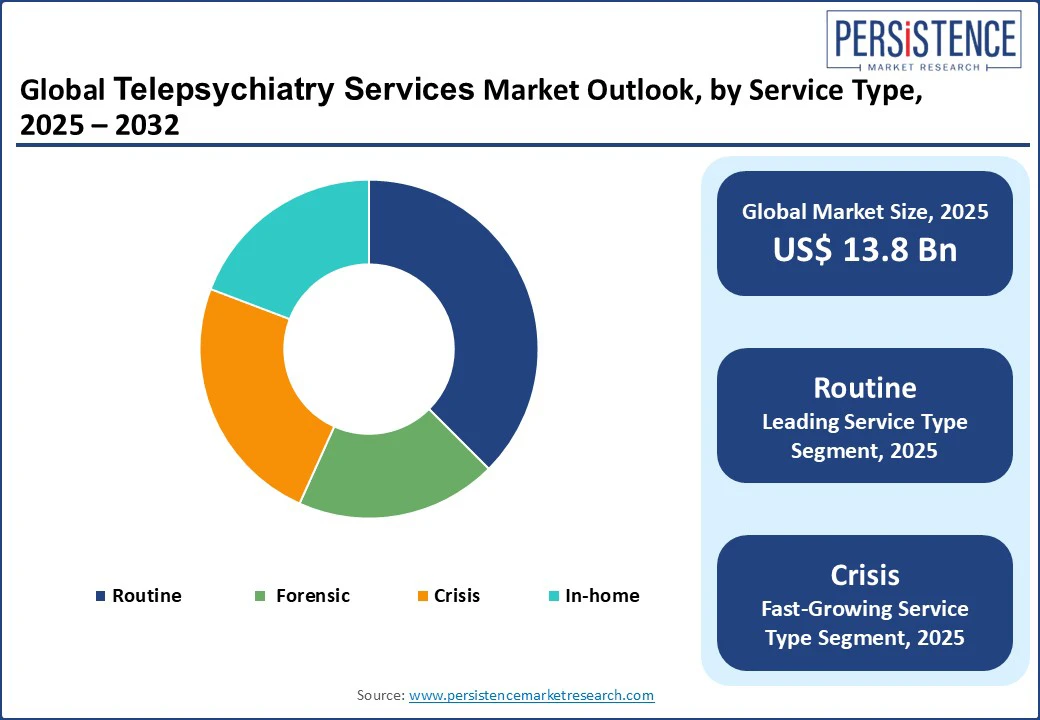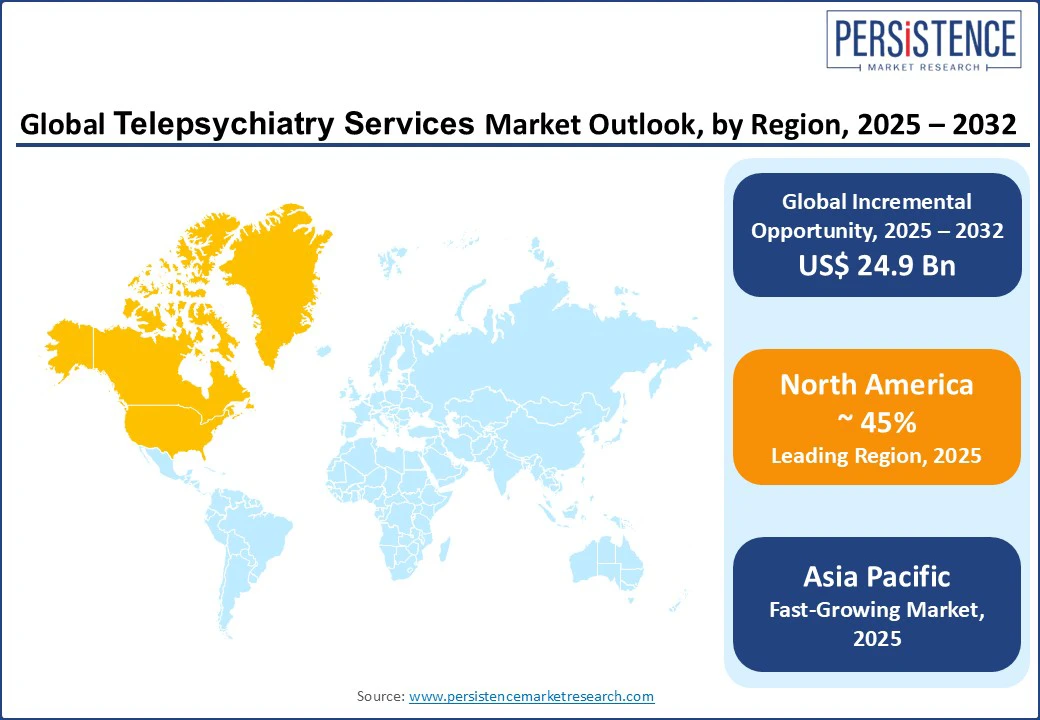ID: PMRREP35561| 175 Pages | 12 Aug 2025 | Format: PDF, Excel, PPT* | Healthcare

The global telepsychiatry services market size is likely to value at US$ 13.8 Bn in 2025 and reach at US$ 38.7 Bn, growing at a CAGR of 18.1% during the forecast period from 2025 to 2032. The global telepsychiatry services market growth is driven by the increasing demand for accessible mental healthcare and the growing integration of digital health technologies. As healthcare systems worldwide increasingly adopt virtual psychiatric consultations to address the shortage of mental health professionals and geographic limitations, the market continues to expand rapidly.
The surge in anxiety, depression, and other psychological disorders exacerbated by lifestyle changes and post-pandemic impacts has significantly boosted the demand for telehealth-based therapy solutions. Moreover, advancements in AI-driven diagnostic tools and mobile telepsychiatry platforms are streamlining patient-provider interactions. Favorable government policies and insurance coverage for virtual care further support the adoption of remote mental health services across both developed and emerging regions.

Key Industry Highlights:
|
Global Market Attribute |
Key Insights |
|
Telepsychiatry Services Market Size (2025E) |
US$ 13.8 Bn |
|
Market Value Forecast (2032F) |
US$ 38.7 Bn |
|
Projected Growth (CAGR 2025 to 2032) |
18.1% |
|
Historical Market Growth (CAGR 2019 to 2024) |
14.4% |
The shortage of licensed psychiatrists in rural healthcare drives the demand for remote psychiatric consultation platforms. Clinics deploy virtual staffing models to extend specialist reach into underserved regions. This ensures faster access to psychiatric evaluations and medication management. Health networks actively schedule follow-ups via video psychiatry appointment systems to optimize provider efficiency. Providers fill gaps in mental health coverage and reduce wait times.
Rapid integration of AI-powered mental health diagnostic tools fuels the adoption of telepsychiatry services. Clinicians use machine-learning models to detect early signs of depression and anxiety via speech and behavioral analytics. Platforms such as Woebot, Mindstrong, and AI-COA accelerate assessment turnaround and personalize treatment plans. This boosts engagement through real-time chatbot therapy tools and predictive relapse alerts. As a result, digital health firms scale telepsychiatry with greater clinical precision.
Clinicians must obtain state-specific telepsychiatry licensure validation, which limits cross-border care delivery significantly. Providers face delays when verifying interstate telepsychiatry practitioner credentials, obstructing seamless service expansion. Unpredictable variability in reimbursement policies, especially around private insurer mental health parity rules, undermines sustainable practitioner participation. Liability concerns around virtual psychiatric malpractice coverage also deter new entrants from offering remote services. These legal and administrative complexities slow the deployment of standardized telepsychiatry.
Digital infrastructure disparities in rural mental health hubs prevent telepsychiatry access for underserved populations. Lack of internet connectivity or compatible devices restricts the uptake of video psychiatry appointment systems in lower-income regions. Low digital literacy among senior or non-tech-savvy patients reduces engagement in virtual psychiatric therapy modules. Clinicians adopting telehealth face workflow disruptions, technical issues, steep learning curves, and resistance to change.
Platforms can scale adoption by launching AI-powered behavioral analytics telepsychiatry tools that predict mood changes using speech, sentiment, and usage data. Providers integrate AI-assisted provider interfaces with empathic response suggestions to boost clinician efficiency and patient rapport. Investing in in-home exposure therapy using VR for anxiety disorders opens new treatment modalities that extend beyond traditional video sessions. Collaborations with schools and pediatric clinics to deploy virtual pediatric psychiatry consultation networks address rising youth mental health demands and underserved rural users.
Expanding routine telepsychiatry integration into community mental health centers helps efficiently address provider shortages and improve reach. Firms entering crisis telepsychiatry response platforms can capitalize on the fast-growing demand for emergency remote psychiatric support in correctional and community settings. The AI-powered pediatric telepsychiatry segment shows strong potential, addressing child and adolescent conditions such as ADHD and depression, with compelling growth forecasts through 2032.
Routine telepsychiatry is anticipated to dominate, with a market share of 39% in 2025, driven by the growing use of scheduled virtual psychiatric consultations for follow-ups and medication management. This growth is further supported by the high frequency of use among patients with chronic conditions such as generalized anxiety disorder (GAD), bipolar disorder, and major depressive disorder (MDD). Increasing employer-sponsored mental health plans and the widespread availability of mobile telehealth apps are making routine virtual visits the standard mode of psychiatric care for long-term mental health management. Integration with Electronic Health Records (EHRs) allows for seamless follow-up scheduling and medication tracking.
Crisis telepsychiatry is projected to be the fastest-growing segment, driven by the surge in emergency psychiatric interventions via telehealth platforms. The demand has risen sharply across emergency departments (EDs), urgent care centers, and community crisis units, particularly in North America, where states such as New York and California have mandated 24/7 telepsychiatric coverage in designated behavioral health centers. This service type is increasingly used for acute cases such as suicidal ideation, violent psychosis, and substance abuse crises, where time-sensitive evaluations are critical.
Adult telepsychiatry services are projected to account for the largest market share of 59% in 2025, as working-age populations increasingly opt for virtual therapy due to convenience, stigma reduction, and better work-life-health balance. Telepsychiatry is especially prevalent in treating occupational burnout, relationship stress, and sleep disorders. Employers, universities, and digital insurers are offering app-based mental health support as part of wellness programs, further reinforcing the dominance of this segment.
Pediatric telepsychiatry is the fastest-growing segment, fueled by increasing awareness of adolescent depression, anxiety, autism spectrum disorders, and ADHD. The COVID-19 pandemic accelerated the normalization of virtual mental health care in schools, with school-linked telehealth platforms now being integrated into IEPs (Individualized Education Programs) and parental support systems. Startups and non-profits are also partnering with pediatricians and school boards to deliver culturally sensitive and age-specific psychiatric care remotely.

North America is anticipated to lead, accounting for a market share of approximately 45% in 2025. The U.S. plays a central role, driven by its advanced digital health infrastructure, wide insurance coverage, and increasing acceptance of mental health platforms. The federal expansion of telehealth waivers under Medicare and Medicaid, especially after the COVID-19 public health emergency, significantly boosted virtual mental health access.
The high smartphone use and the proliferation of cloud-based mental health platforms such as Teladoc Health, Amwell, MDLIVE, and Talkspace have improved patient engagement, particularly among adults aged 25 to 50. Moreover, rising cases of PTSD, anxiety, and substance use disorder among veterans and youth have pushed demand for on-demand psychiatric care and real-time monitoring services.
The U.S. is also witnessing innovation in AI-enabled therapy modules and virtual crisis stabilization units. Behavioral health startups are integrating voice, facial recognition, and mobile diagnostics to enhance remote evaluations. Canada, on the other hand, is scaling province-led telepsychiatry initiatives, especially in British Columbia and Ontario, to reach indigenous and remote communities, making it a key growth pocket in the region.
Asia Pacific is the fastest-growing region in the global telepsychiatry market, projected to register a CAGR of over 16.4% from 2025 to 2032. This surge is largely attributed to rising mental health awareness, increasing mobile and internet penetration, and growing urban-rural healthcare disparities. India and China collectively contribute to a major share of this growth due to their large populations and unmet psychiatric care needs.
India has seen the rapid emergence of government-supported telepsychiatry programs, such as the NIMHANS Tele-MANAS project, which offers free teleconsultation services nationwide. In rural areas, NGOs and startups are deploying low-bandwidth telepsychiatry solutions to reach tribal and underserved populations. Mental health startups such as Wysa and Lissun are integrating chatbot-based cognitive behavioral therapy (CBT) to serve youth and first-time mental health seekers.
China’s growth is fueled by increasing rates of depression and anxiety, especially among teenagers and the elderly, along with government-backed digital health expansion under the Healthy China 2030 initiative. Key players are introducing mobile-based psychiatric care apps with Mandarin language support and AI integration for better patient adherence and mood tracking.
Europe holds a significant position in the global telepsychiatry services market. The region’s growth is propelled by supportive regulatory frameworks under the EU’s Digital Health Strategy and strong adoption of mental health services within national health systems (NHS in the U.K., Assurance Maladie in France, etc.). The U.K. has been at the forefront, scaling NHS-commissioned telepsychiatry hubs to address the increasing waitlist for in-person appointments. Digital-first services such as Ieso Digital Health and Kooth are expanding access to digital cognitive behavioral therapy (dCBT) and adolescent mental health support. Germany’s Digital Healthcare Act (DVG) has further paved the way for reimbursable telepsychiatric app-based prescriptions, making virtual therapy more accessible.
France, Spain, and Italy are witnessing strong post-pandemic demand for remote consultations, especially for geriatric and postnatal depression treatment. Cross-border teleconsultation services within the EU are gradually gaining ground, allowing licensed psychiatrists to serve multilingual populations across neighboring countries. However, rural areas across Central and Eastern Europe still face digital divide challenges, providing untapped opportunities for cloud-based telepsychiatry platforms with offline functionality or asynchronous communication.

The global telepsychiatry services market is characterized by moderate fragmentation, with a mix of well-established healthcare conglomerates, digital health innovators, and niche telepsychiatry providers. Companies are increasingly competing not just on platform reach but on the ability to offer specialized, outcome-driven virtual psychiatric care. Industry leaders are leveraging AI integration, mental health app ecosystems, and hybrid care models to differentiate their offerings and expand into underserved segments such as pediatric and forensic telepsychiatry.
Key players shaping the market include Teladoc Health, Amwell, MDLIVE (Evernorth), Talkspace, and BetterHelp. Strategic expansion is also targeting high-need institutional markets such as schools, correctional facilities, and rural health networks. Companies such as Access TeleCare (formerly SOC Telemed) and Arcadian Telepsychiatry have established strong networks in correctional psychiatry, forensic assessments, and emergency psychiatric response.
The global telepsychiatry services market is expected to be valued at US$ 13.8 Bn in 2025.
By 2032, the market is projected to reach approximately US$ 38.7 Bn, reflecting robust growth across virtual mental health care platforms.
Key trends include the integration of AI-based diagnostic tools, mobile mental health app expansion, hybrid care models, and rising demand for adolescent and pediatric telepsychiatry. The sector is also seeing strong traction in rural and underserved regions.
The crisis telepsychiatry segment held the largest market share in 2024 and continues to dominate due to its role in emergency mental health services across hospitals and correctional facilities.
The market is forecast to grow at a CAGR of 18.1% from 2025 to 2032, driven by digital health innovations, government backing, and increased mental health awareness post-COVID-19.
The key players include Teladoc Health, Inc., Amwell (American Well Corporation), MDLIVE (Evernorth/Cigna), Talkspace, Inc., and Wysa.
|
Report Attribute |
Details |
|
Historical Data/Actuals |
2019 - 2024 |
|
Forecast Period |
2025 - 2032 |
|
Market Analysis |
Value: US$ Bn |
|
Geographical Coverage |
|
|
Segmental Coverage |
|
|
Competitive Analysis |
|
|
Report Highlights |
|
|
Customization and Pricing |
Available upon request |
By Service Type
By Age Group
By Modality
By End-user
By Region
Delivery Timelines
For more information on this report and its delivery timelines please get in touch with our sales team.
About Author